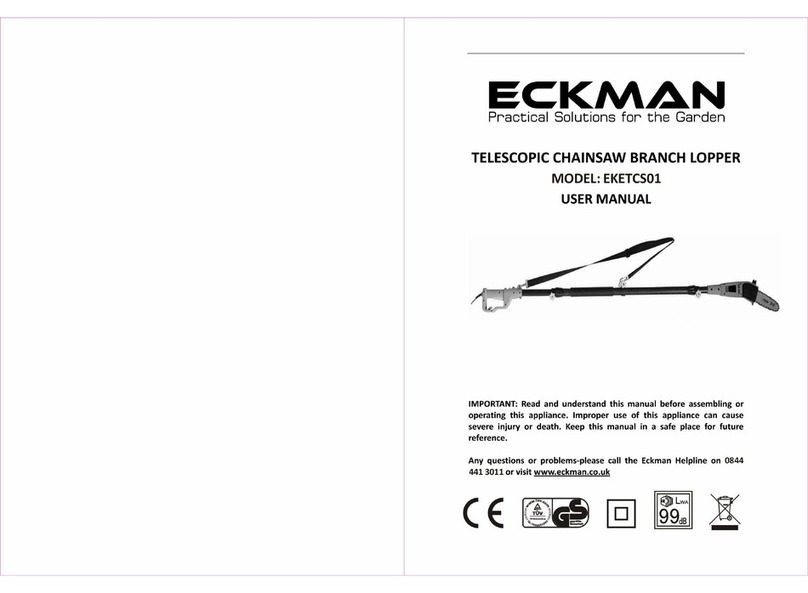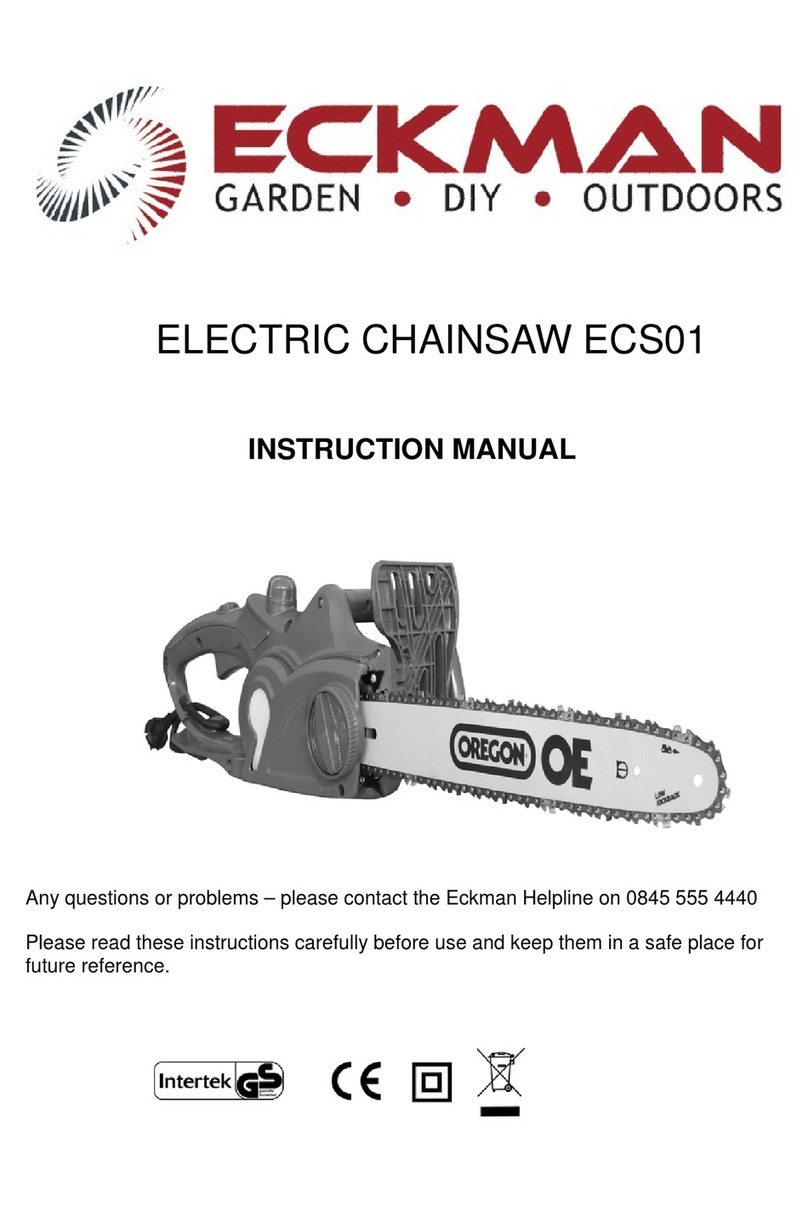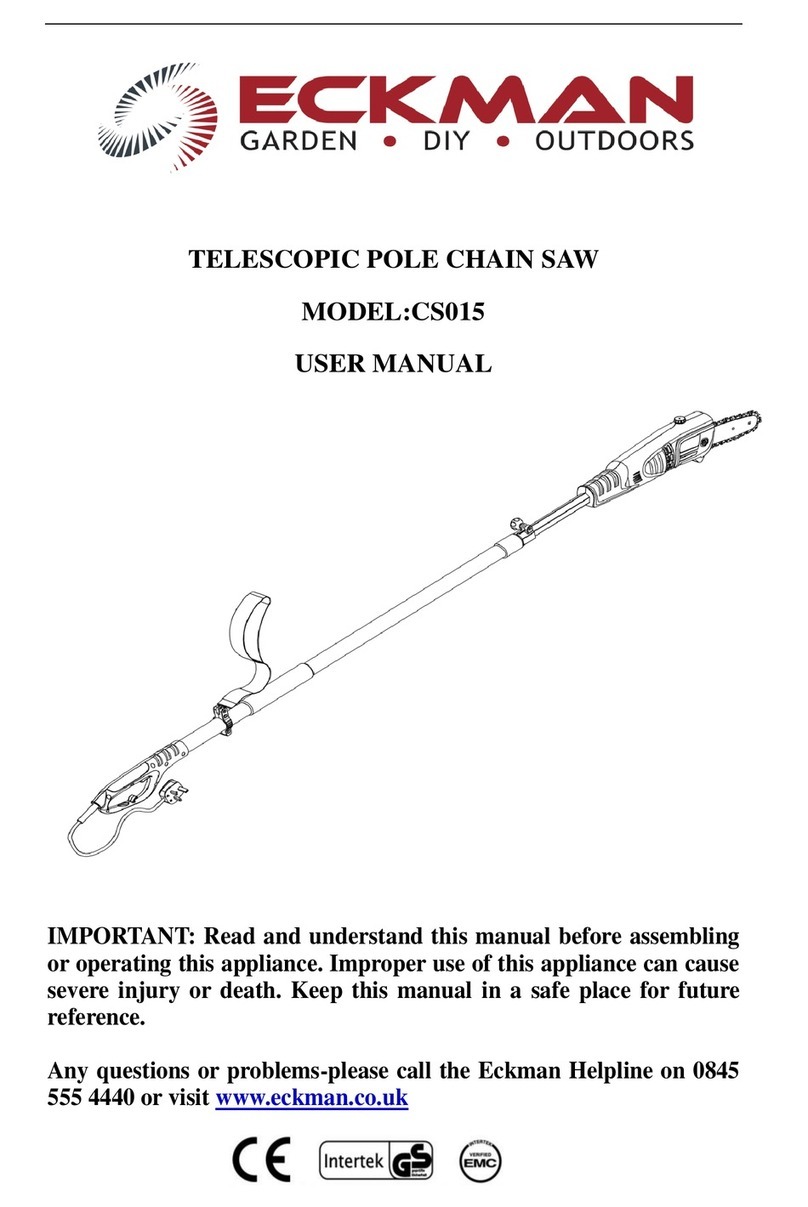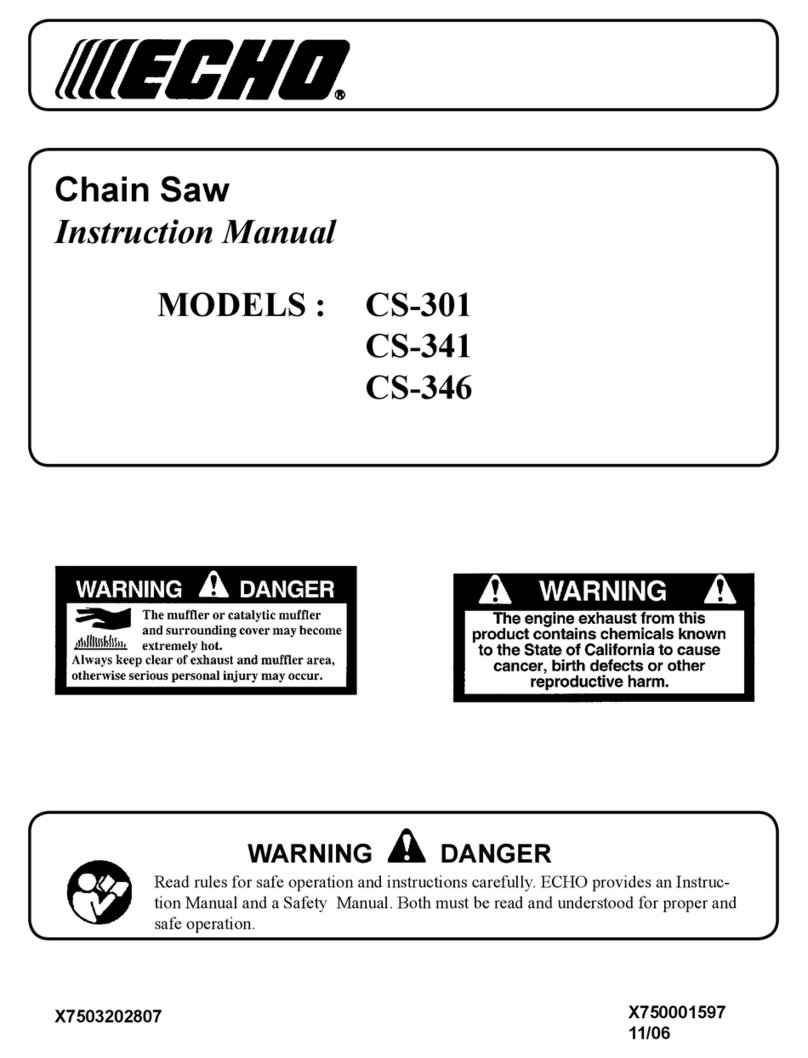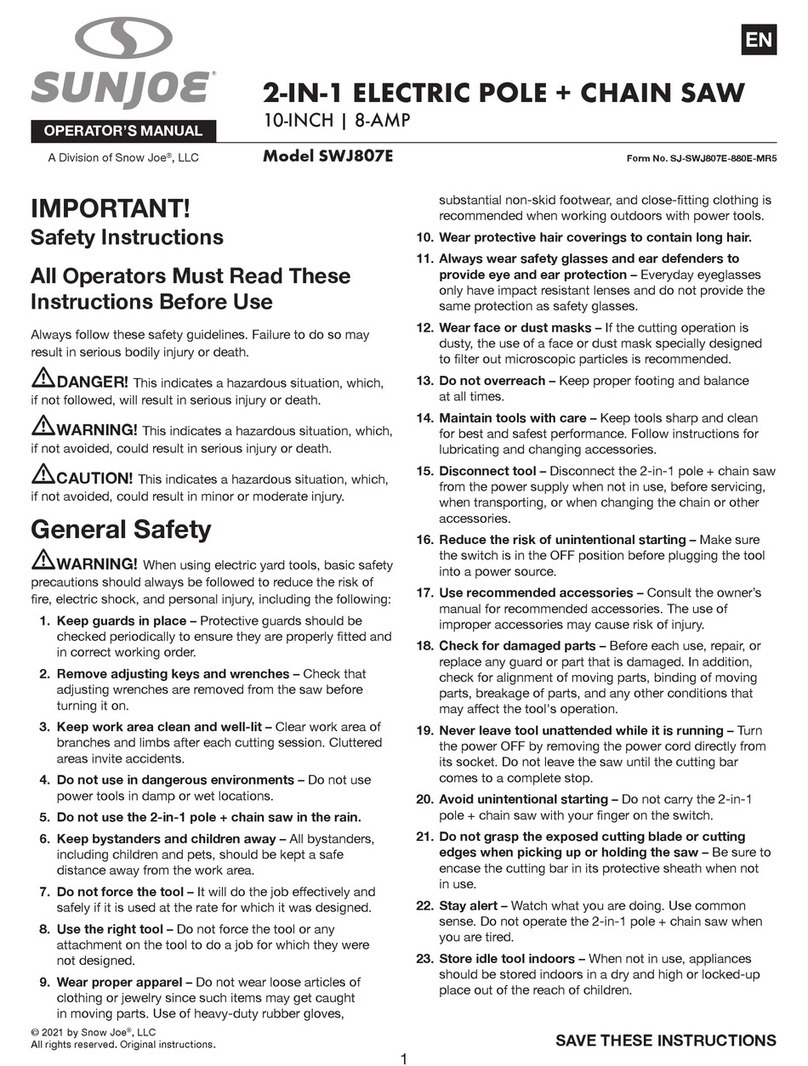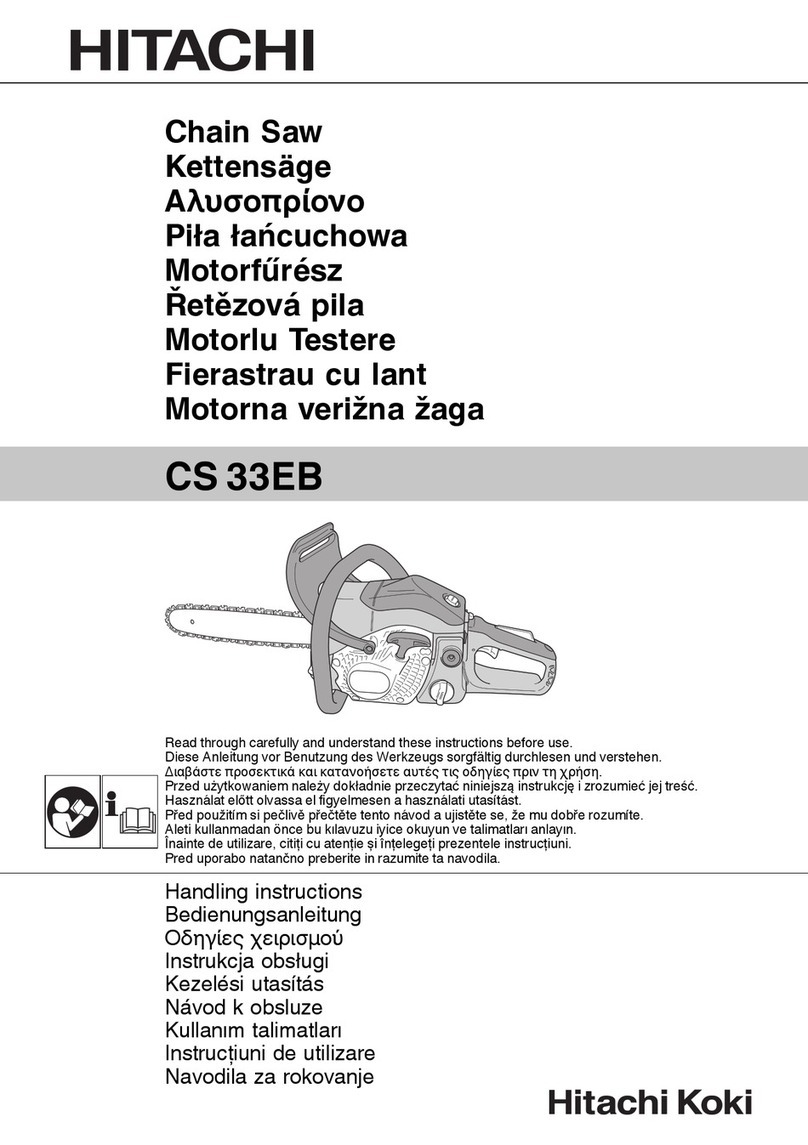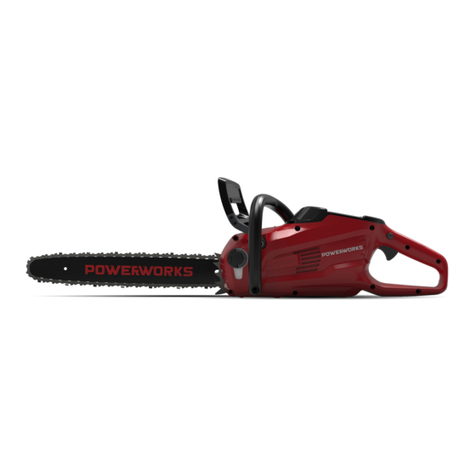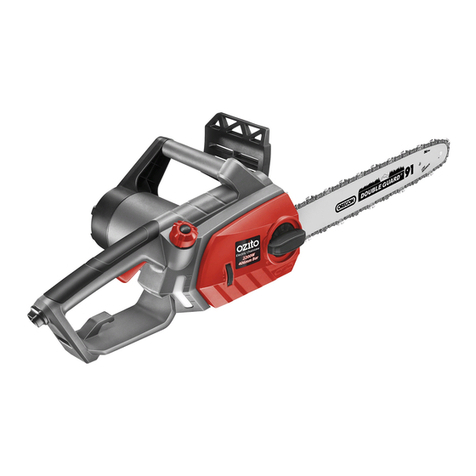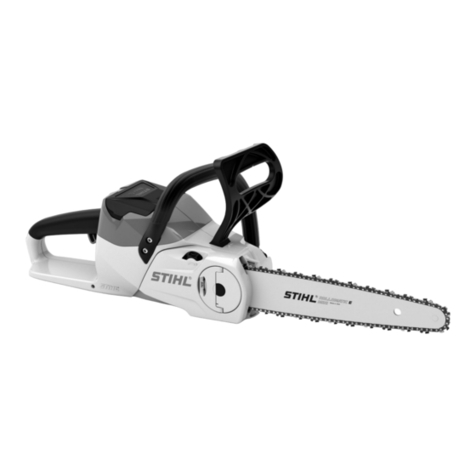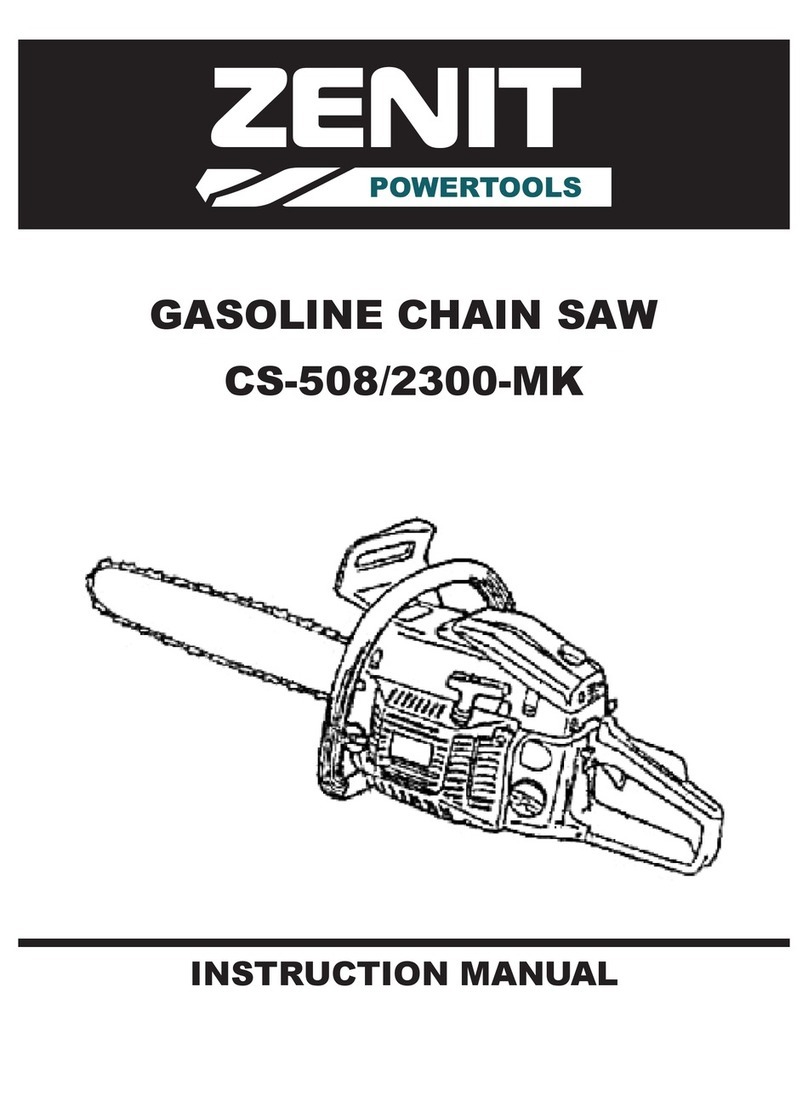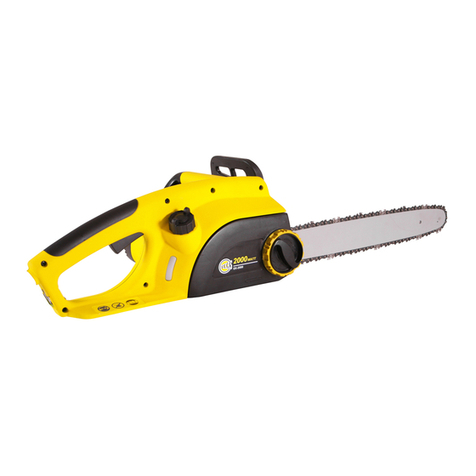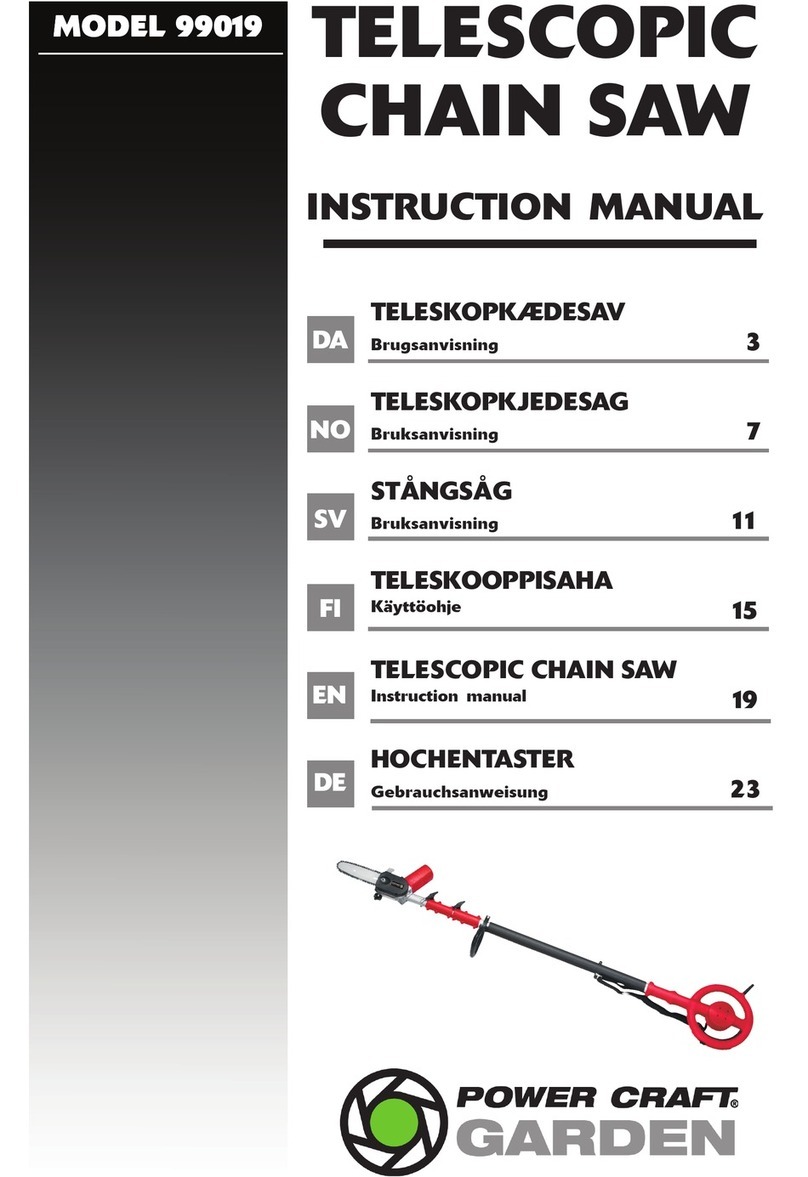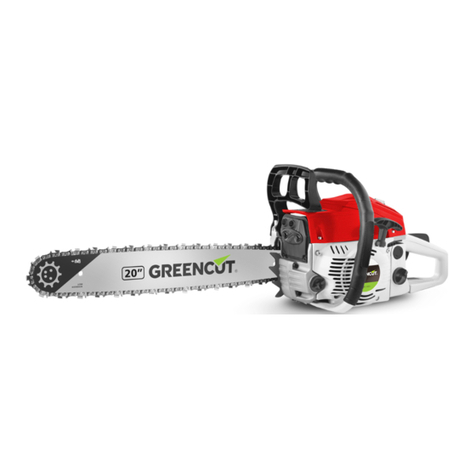Eckman EKECS03 User manual

2400W ELECTRIC CHAIN SAW
MODEL EKECS03
INSTRUCTION MANUAL
PLEASE READ AND SAVE THE INSTRUCTION MANUAL FOR FUTURE REFERENCE
Any questions please call the Eckman helpline on:0844 441 3011 or go to www.eckman.co.uk

- 1 -
Contents
Environmental protection....................................................................................- 2 -
Safety instructions.................................................................................................- 2 -
Description of symbols.........................................................................................- 2 -
Safety rules.............................................................................................................. - 3 -
Technical data..........................................................................................................- 5 -
Parts identification................................................................................................. - 6 -
Setting chain and chain bar............................................................................... - 6 -
Setting the chainsaw tension............................................................................ - 8 -
Oil filling.....................................................................................................................- 8 -
Checking the automatic oil function............................................................... - 9 -
Avoiding kickback...................................................................................................- 9 -
Avoid jamming........................................................................................................ - 9 -
Power cord support............................................................................................... - 9 -
Before start-up........................................................................................................- 9 -
Start up and stop................................................................................................... - 9 -
Operating the electric chain saw................................................................... - 10 -
Bucking....................................................................................................................- 10 -
Chain brake............................................................................................................- 13 -
Chain sharpening.................................................................................................- 13 -
Chainsaw maintenance......................................................................................- 14 -
First time user.......................................................................................................- 15 -
General inspection...............................................................................................- 15 -
Power cord maintenance.................................................................................. - 15 -
Storage.................................................................................................................... - 15 -
Troubleshooting....................................................................................................- 15 -
Guarantee .............................................................................................................- 16 -
EC declaration of conformity..............................................................................-17-
Exploded view and parts list....................................................................... -18-19-

- 2 -
Environmental protection
Waste electric products should not be disposed of with household waste. Please
recycle check with your local Authority or retailer for recycling advice.
Safety instructions
Before using the chainsaw, please read the following instructions and follow them during
operation! Please “Save all warnings and instructions for future reference”. Failure to follow
instructions could result in electric shock, fire or serious injury to user. We highly recommend
the use of an RCD (Residual Current Detector) when using electrical equipment.
Description of symbols
Read the instruction manual carefully
Denotes risk of personal injury, loss of life, or damage to the tool in case of
non-observance.
Contact of the guide bar tip with any object should be avoided. Tip contact may
cause the guide bar to move suddenly upward and backwards, which may cause
serious injury to user.
Two hands are always to be used in operation of the chainsaw.
WARNING: To reduce the risk of electric shock do not expose unit to water or
operate unit on wet ground
Remove the plug from the socket or mains immediately before carrying out any
adjustments, servicing or maintenance or if the cable is damaged or cut.
Obtain and wear CC approved eye and ear protection at all times while
operating the equipment.
Use protective gloves
Wear sturdy, non-slip footwear

- 3 -
Safety rules – general and for electric chainsaws
1. Replacement Parts. When servicing, use only identical replacement parts.
2. Plugs. Do not modify the plug connected to the power lead in any way.
3. Cleanliness. Keep Work Area Clean. Cluttered areas invite injuries.
Do not start cutting until you have a clear work area, secure footing, and a planned
retreat path from the falling tree.
4. Environment. Consider your local environment, including any neighbors.
5. Cutting Small Branches. Use extreme caution when cutting small size brush and
saplings because the slender material may catch the saw chain and be whipped toward
you or pull you off balance. When cutting a limb that is under tension, be alert for spring
back so that you will not be struck when the tension in the wood fibers are released.
6. Working Conditions. Do not expose chainsaw to rain or use in damp or wet locations or
in the presence of flammable liquids or gases.
7. Guard Against Electric Shock. Prevent body contact with grounded surfaces. For
example: metal pipes, wire fences etc and preferably use in conjunction with an RCD.
These are inexpensive and can be purchased from most hardware shops.
8. Children. Keep children away from this equipment at all times.
9. Storage. When not in use, chainsaws should be stored in a dry, high, or locked up place
out of the reach of children and with the chain cover supplied in place.
10. Use Correct Force. Let the chain do the work ! Using force won’t help, can be
dangerous, and probably means your saw requires sharpening.
11. Only use this saw to cut wood.
12. Dress Properly. Do not wear loose clothing or jewelry as they could get caught in
moving parts. Rubber or leather gloves and nonskid footwear are recommended when
working outdoors. Wear protective hair covering to contain long hair. Use CE approved
safety goggles, head and preferably ear protectors.
13. Transporting The Chainsaw. Carry the chainsaw by the front handle with the saw
stopped, finger off the switch, the guide bar and saw chain to the rear. Keep the chain
cover fitted.
14. Maintenance.

- 4 -
Inspect periodically and if damaged, have repaired by authorized service facility. Keep
mains power lead clear of the chain and operator at all times. Never carry saw by the
mains lead and keep cord away from oil and sharp edges.
Keep the chain sharp, clean, and properly tension-adjusted for better and safer
performance.
Follow instructions for lubricating and changing accessories.
Keep handles dry, clean, and free from oil and grease.
15. When Not In Use. Disconnect chain saw when not in use, before servicing, and when
changing accessories and attachments, such as saw chain and guard.
16. Extension Cords. Use only extension cords intended for use outdoors and so marked.
17. Stay Alert. Watch what you are doing. Use common sense. Do not operate chainsaw
when you are tired. Keep all parts of the body away from the saw chain when the motor
is operating. Before you start the saw, make sure the saw chain is not contacting
anything.
18. Before use
Constantly check for any damaged parts.
That the chain brake operates correctly.
That the oil reservoir is filled with oil.
19. Kickback.
WARNING: Kickback may occur when the nose or tip of the guide bar touches an object,
or when the wood closes in and pinches the saw chain in the cut. Tip contact in some
cases may cause a lightning fast reverse reaction, kicking the guide bar up and back
towards the operator. Pinching the saw chain along the top of the guide bar may push
the guide bar rapidly back towards the operator. Either of these reactions may cause you
to lose control of the saw that could result in serious injury to user. The following
precautions should be followed to minimize kickback.
①. Grip Saw Firmly.
Hold the chain saw firmly with both hands when the motor is running. Use a firm grip
with thumbs and fingers encircling the chain saw handles.
②. Do not over reach.
③. Keep proper footing and balance at all times.
④. Don’t let the nose of the guide bar contact a log, branch, ground or other obstruction.
⑤. Don’t cut above shoulder height.
⑥. Use devices such as low kickback chain, guide bar nose guard, chain brakes and special
guide bars that reduce the risks associated with kickback.

- 5 -
⑦. Only use replacement bars and chains specified by the manufacturer or the equivalent.
20. Power Supply. Connect chain saw to correct voltage, that is, be sure that the voltage
supplied is the same as that specified on the nameplate of the tool.
Technical data
Factory Model/Eckman Model
SF7J101/EKECS03
Voltage
230V-50HZ
Rated Power
2400w
No Load Speed
14m/s
Max. Cutting Length
395mm
Guide Bar/Chain Saw
Oregon Professional
Chain Pitch
9.53mm
Chain Gauge
1.27mm
Sprocket
7T
Net Weight
6.6 kgs
Gross Weight
7.6 kgs
Oil Tank Capacity(with Automatic/Regulated
Lubrication)
110ml
Sound Pressure Level(LpA)
97dB(A)k=3dB(A)
Sound Power Level(LwA)
110dB(A)k=3dB(A)
Vibration Emission Level
4.5m/s2K=1.5m/s2
Protection Class
Double Insulation
Oregon Bar Length
18’’(512mm)
Number of Teeth on Chain
62 Teeth

- 6 -
Start Type
Soft Touch Start
Function of LED Indicator
Power Overload Indicator
Parts identification
1Cable + plug (UK plug supplied)
2Rear handle
3On/Off switch
4Lock-off button
5Oil Tank cap
6Front handle
7Activation lever for kickback
brake (hand guard)
8Nose sprocket
9Oregon bar
10 Oregon Chain
11 Gripping teeth
12 Tensioning ring
13 Lock knob
14.Cover plate
15 Oil Level window
16 Cable hook
17 Chain guard
18 Brush cap
19 LED overload function indicator
17

- 7 -
Setting chain and chain bar
Chain and chain bar assembly for model with SDS tool-less tensioning system
Place the chainsaw with the motor on a cover to avoid any mess from
the oil.
Place the chain in the grove of the bar. Pay attention to the correct
running direction. As shown by the running direction symbol.
1. Place the chain links around the drive sprocket and let the fastening bolt pass through the
gap of bar. ( See Fig. 1-2)
2. Check if all parts are seated properly and hold chain and chain bar in a level position.
Fit cover and match the tension ring properly, then tighten the lock knob clockwise.
(See Fig.3)
Drive sprocket
Fastening bolt
Fig.2
Fig.1
Drive sprocket
Fastening bolt
Tension ring
Lock knob
Fig.3
Fig.2

- 8 -
Setting the chainsaw tension
Tensioning chain for model with SDS tool-less tensioning system
Loosen the lock knob by turning it anti-clockwise approximately 1-2 turns.
Check whether all chain links lie correctly in the guide tracks of the bar.
Press the tension ring inwards and turn it in a clockwise direction until the correct chain tension
is reached.
The correct tension is reached when the chain in the middle of the bar can only be raised by
approximately 3-4mm. Please see figure as below.
Oil filling
Note. The chainsaw is shipped without oil in it. The chain saw must never be used without oil or
with an oil level that is below the indicator. SAE #0W-30 is ideally recommended for general
use.
WARNING. Always ensure that the chainsaw is switched off and the plug is removed from the
power point before making any adjustments.
1.Remove oil cap and fill the tank with chain oil. Replace the oil tank cap and tighten well.
2.Lubrication is activated only when the machine is working.
3.Check the oil level periodically through the oil level indicator.
Use good quality ecological chain oil to ensure long life for the moving parts. Do not use
recovered or pre-used oil containing impurities.
Make sure that no dirt gets into the oil tank.
Oil level
window

- 9 -
Checking the automatic oil function
Switch on the chainsaw, rev it up and point the tip of the saw towards a piece of paper laying on
the ground. If a patch of oil appears and becomes larger, then the automatic oil function is
working. If there are no traces of oil even though the oil tank is full, then the automatic oil
function is not working.
If the automatic oil function is not working, remove the chain bar and clean out the oil ways of
the chainsaw and chain bar. After reassembly, if the chainsaw is still not working, please take
it to an authorized service centre.
Avoiding kickback
Be constantly aware of the position of the upper quadrant of the blade tip. This is the part that
triggers a kickback when it hits resistance.
Never engage the upper quadrant of the guide bar with whatever you are cutting. Look out for
hidden branches or obstructions. Ensure there is a clear work area.
Always clear away brush, vegetation and any obstructing debris before attempting a cut that
might trigger a kickback.
Avoid cuts that will cause the chainsaw to jam in a tree trunk or limb.
Avoid jamming
Always cut into the compression wood first until the cut starts to close. Always make the
compression cut beneath of the log or limb is suspended from one end and on top if it is
supported at both ends. Cut from the other side towards the compression cut. Make a habit of
using a wedge to prevent the compression cut jamming tighten the chainsaw blade.
Power cord support
During use of the chainsaw the power cord will continually be pulled
as you move from one area to another.
A cord retention hook has been provided on the
chainsaw housing.
Before start-up
1. Check the machine and cable are in good working order before starting the chainsaw.
2. Make sure that the chain lubrication is working and check the oil level.
3. Check the chain tension and the operation of the chain brake.
Start up and stop
1. Remove the bar cover.
2. Release the chain brake by pulling the front hand guard, firmly towards the back of the
electric chain saw until a click is heard. To check the chain brake has been released, you
should be able to move the chain by hand.
3. Connect the cable to the power.

- 10 -
Note. Ensure the brake is working efficiency, check its operation every time you
use the chain saw before commencing work with it.
WARNING. The trigger must never be depressed before pulling back the front hand
guard.
1.Hold the electric chain saw by its grip with both hands.
2.To start the chainsaw, squeeze the trigger lock-out, then squeeze the trigger.
To stop the chain saw, release the trigger or trigger lock-out, either will stop the machine.
WARNING. Hold the electric chain saw with both hands until the chain is completely still.
Operating the electric chain saw
Safe chainsaw operation whilst cutting - always:
1. Run the chainsaw motor at full revs. This makes the job safer, as there is less chance of pull-in or
kick-back.
2. Position your body to the left of the chainsaw so if it kicks back uncontrollably, it goes over your right
shoulder.
3. Keep a firm grip with your left hand on the front handle, with your thumb securely below the handle. The
swivel of your wrist in a kick-back situation will activate the chain brake.
4. Make sure the chain is tensioned correctly.
5. Observe the size of wood shavings, if they become dusty your chain probably needs sharpening.
Important note: The LED indicator turns green while the chainsaw is working properly and will
turn red if the power is over-loaded.
Bucking
Bucking is cutting a fallen log into lengths. Make sure that you have a good footing and stand
uphill of the log when cutting on sloping ground. If possible, the log should be supported so that
the end to be cut off is not resting on the ground. If the log is supported at both ends and you
must cut in the middle, make downward cut halfway through the log and then make the
undercut. This will prevent the log from pinching the bar and chain. Be careful that the chain
does not cut into the ground when bucking as this causes rapid dulling of the chain.
WARNING. Do not touch protruding branches with the bar tip to prevent kickback.
1. Use the metal gripping teeth to secure the saw onto the wood, before starting to cut. Use the
gripping teeth as a leverage point “X” while cutting.
Please see figure on the right.
Lock-out button
Trigger

- 11 -
2. Reset the gripping teeth at a lower point when sawing thicker logs by pulling the chain saw
slightly backwards, until the gripping teeth release, and reposition at lower level to continue
sawing. Do not remove the saw completely from the wood.
3. Log supported along entire length: cut from bottom under buck),being careful to avoid
cutting into the ground
4. Log supported on one end proceed as if using a saw-horse:
First, cut from bottom (under buck) 1/3 diameter of log to avoid splintering.
Second, cut from above (over buck) to meet first cut avoid pinching
5. Log supported on both ends:
First, you must cut in the middle
Second, over buck 1/3 diameter of log to avoid splintering.
Third, under buck to meet first cut and avoid pinching.
Note: The best way to hold a log while bucking is to use a saw horse. When this is not
possible, the log should be raised and supported by limb stumps or by using supporting logs.
Be sure the log being cut is securely supported.
Please see figure on the right
● BUCKING USING A SAWHORSE
1. Hold the saw firmly with both hands and keep the saw to the right of your body
while cutting.
2. Keep the left arm as straight as possible.
3. Keep weight on both feet.
Please see figure on the right
● The machine should only be used under reliable support conditions. The machine
should be held to the right of the body and at a slight distance.
● The chain needs to be moving at full speed before coming into contact with the wood.
1. Hold the saw firmly with both hands and keep the saw to the right of your body while
cutting. Keep the left arm as straight as possible with equal weight on both feet.
Felling a tree.

- 12 -
●To fell trees, observe all the safety regulations and proceed as follows:
The chainsaw may be used to fell only trees which are smaller in diameter than the length of the
bar and chain. If the saw chain gets jammed, release it using a wooden wedge.
●Felling trees is dangerous and requires practice. If you are inexperienced, do not try to teach
yourself but seek professional training.
Falling direction:
First estimate the direction of fall, taking into account the centre of gravity of the crown and the
wind direction.
Switch on the chain saw and saw an undercut in the tree in the direction of fall and then
make a horizontal cut (back cut) on the side opposite to the undercut. Make the undercut: This
will give the tree a direction and guidance.
- Check the direction of fall: If you have to correct the undercut, always re-cut over the entire
width.
-Now call “Timber”!
- Only now make the back cut, which must be higher than the sole of the undercut. Insert
wedges in time.
- Leave the wedge in place as it will function as a hinge. If you cut through the wedge, the tree
will fall randomly.
-Fell the tree by driving a wedge into the back cut, not by sawing through it.
When the tree falls, step back and watch the crown.
Wait for the crown to stop swinging. Do not continue working under branches which have got
stuck.

- 13 -
Chain brake
In the event of kick-back, the chain brake will be actuated via the front finger guard. The front
finger guard is pushed forwards by the back of the hand and this causes the chain brake to stop
the chain saw, or rather the motor, within 0.15 of a second.
Releasing the chain brake:
To be able to use your chain saw again, you must release the saw chain again. First, switch off
the chainsaw. Then push the front finger guard back into the vertical position until it locks in
place (figure as below). The chain brake is now fully functional again.
Chain sharpening
It is highly recommended that once the chain loses its ability to cut cleanly and safely, either
replace it, have it sharpened by any garden equipment maintenance company, or sharpen it
yourself.
To sharpen the chain refer to below and proceed as follows:
Disconnect from the mains supply
Wear protective gloves.
Ensure the chain is correctly tensioned.
Engage the chain brake to lock the chain on the bar.
Use a round file (available from all good garden equipment companies) whose diameter is
1.1 times the cutting tooth depth.
File at an angle perpendicular to the bar, and 38° to the direction of travel.
File each tooth from inside towards outside only.
Sharpen each tooth equally by using the same number of strokes.
Check the safety depth gauge height every 5th-chain sharpening.
If the depth gauges are also trimmed it is essential that the original profile be restored.
Use a depth gauge measuring instrument to check the height of the depth gauge. Depth
gauge measuring jigs are available from most reputable tool merchants.(see figure as
below)

- 14 -
Chainsaw maintenance
WARNING. Always ensure that the machine is switched off and the plug is removed from the
power point before making any adjustments or maintenance procedures.
1. Always keep the air holes clean on the electric chainsaw body. They tend to become clogged
with sawdust during use and this affects the efficiency of cooling, causing overheating of the
motor. Electric motors that become damaged due to being clogged up with debris are
not covered by this warranty.
2. Do not operate the chainsaw with the air intake on the ground as this will draw foreign
particles into the motor area and damage the windings of the motor.
3. Regularly check to see if any dust or foreign matter has entered the grills near the motor and
around the on/off switch. Use a soft brush and/or vacuum to remove any accumulated dust.
Wear safety glasses to protect your eyes whilst cleaning.
4. If the body of the tool needs cleaning, wipe it with a soft damp cloth. A mild detergent can be
used. Do not use alcohol, petrol or other cleaning agents or abrasives.
5. Never use caustic agents to clean plastic parts.
6. Turn the bar periodically to use both the sides so that it wears evenly.
7. It is essential that motor cooling vents are kept free from a build-up of sawdust and this
decreases the engines tools cooling capacity and causes overheating equipment, oil pump etc.
It is recommended that this is carried out after every use.
8. Clean the guide and oil holes periodically.
9. De-burr the race sides periodically with a flat file. Time may cause any “burrs” to detach and
damage the bar.
10. The bar needs to be evened with a flat file if one of the races is higher than another and then
smoothed with a file and fine sandpaper. If races are considerably worn, check that the height

- 15 -
is always greater than the chain’s transmission links so that the latter do not touch the bottom.
Replace the bar if required.
The chainsaw should be periodically serviced to check the correct operation of the chain, chain
drive, motor and brake.
CAUTION: Water must never come into contact with the machine.
First time user
If you are not familiar with chainsaws and the felling of trees, it is recommended that you obtain
informed instructions in addition to reading this manual fully. We also recommend as a
minimum that you practice cutting logs in a saw-horse or log cradle.
General inspection
Regularly check that all fixing screws, nuts and bolts etc are tight. They may vibrate loose over
time.
Power cord maintenance
If the supply cord gets damaged in any way and needs replacing, the task must be carried out
by the manufacturer, the manufacturer’s agent, or an authorized service centre in order to
avoid a safety hazard.
Storage
Clean the electric chain saw with a dry cloth, do not use aggressive cleaning fluids.
Replace the electric chain saw blade cover and store in a dry place. Do not store in hot, dry
boiler rooms or other damp places.
TROUBLESHOOTING
Motor does not run
No electricity
Check socket, cables and plugs.
Damaged cable: Have repaired by a
service agent.
Do not patch cables with insulation tape.
Damaged switch: Have repaired by a
service agent.
See section on chain brake.
Worn carbon brushes
Carbon brushes need replacing.
Chain does not move
Chain brake
Check the chain brake and release if
necessary.

- 16 -
Poor cutting performance
Blunt saw chain
Sharpen or replace the saw chain.
Chain tension
Check chain tension.
Saw chain fitted
incorrectly
Check saw chain
Chain jumps off guide bar
Chain tension
Check chain tension.
Chain works with difficulty
Chain tension
Check chain tension.
Chain becomes hot
Chain lubricant
Check oil level. Check chain lubrication.
Guarantee
This product is guaranteed against faulty workmanship for a period of 36 months from the
date of purchase. If the product is modified in any way or not used in accordance with
these instructions, your guarantee will be void. Your statutory rights remain unaffected.

- 17 -
EC Declaration of Conformity
We, the
ZHEJIANG SAFUN INDUSTRIAL CO.,LTD
Address: 7 South Mingyuan AVE,Economic Development Zone,Yongkang, Zhejiang China hereby
declare by our own responsibility that the product :
CHAIN SAW ,TYPE SF7J101-24-SLN (EKMAN MODEL EKECS03)
Is according to the basic requirements ,which are defined in the European directives :
-2004/108/EC Annex II (EMC Directive)
2006/42/EC (Machinery Directive )
And their amendments.
For the evaluation of conformity ,the following harmonized standards were consulted and applied:
EN 55014-1/A2:2011, EN 55014-2/A2:2008,EN61000-3-2/A2:2009, EN61000-3-3:2013
EN 60745-1/A11:2010,EN60745-2-13/A1:2010;
Test Report :
Ref. No.: MD-SH11060788-001+A1:2013/EMC- SH11060789-001/A1
Jinhua , July,2015
(Manufacturing Factory Stamp)
IMPORTED BY ECKMAN CO.,LTD
ADD: 29 WELBECK STREET,LONDON W1G 8DA, ENGLAND

- 18 -

- 19 -
This manual suits for next models
1
Table of contents
Other Eckman Chainsaw manuals
